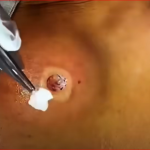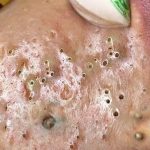What Causes Blackheads?Blackheads, also known as open comedones, form when dead skin cells, sebum, and bacteria become trapped in a hair follicle. This is due to a clogged pore that doesn’t let the skin cell and oil debris escape. As a result, a blackhead forms. They can appear on the nose, chin, forehead, chest, and other areas of the body. To prevent blackheads from forming, it’s important to regularly wash your face with a gentle cleanser to remove dirt and oils. Exfoliating two to three times per week can also help to keep pores unclogged and avoid the buildup of dead skin cells. However, if blackheads do form, there are ways to treat them. One method is popping or squeezing the blackheads. Dr. Fua can incorporate all of these treatment options into your acne treatment plan, depending on what works for your skin.
If topical treatment alone does not improve acne, or if acne is severe or extensive, oral medications are the best option. If you’ve tried several topical medications without success, or if your condition is severe, oral acne medications are usually the next step in the treatment process. Treatment usually includes oral antibiotics and applying a prescription gel or topical cream to the skin. Depending on people with acne, treatment may include using prescription creams to prevent acne, taking antibiotics to kill bacteria that contribute to acne, or, if acne is severe, taking stronger medications such as like isotretinoin, or even minor surgery. Even if you have tried topical acne treatments such as creams or gels without any lasting results, laser therapy may be the right solution for you. While I would like you to try natural remedies first, if you are not seeing improvement and severe hormonal acne is making your quality of life worse, other treatments can make a real difference. While it may take a while, treating hormonal acne from the inside out until your hormones are in their natural, happy balance will allow your skin to truly heal.
-
Clean extraction of the cyst contents
-
Complete removal of the cyst sac
-
Minimal bleeding or trauma
-
Instant visual relief
-
Low risk of recurrence
Here’s how the most satisfying and successful cyst removals are done:
✅ Steps for the Most Satisfying (and Effective) Cyst Removal
1. Proper Diagnosis
-
Confirm it’s a sebaceous/epidermoid cyst, not a lipoma or abscess.
-
Check if it’s infected or inflamed — infected cysts must be treated differently.
2. Prepare the Area
-
Cleanse the skin with antiseptic.
-
Local anesthesia is injected to numb the site (lidocaine is most common).
-
Mark the incision line (often over the punctum if visible).
3. Make a Small, Strategic Incision
-
A small linear cut or elliptical excision is made directly over the cyst.
-
The goal is to access the cyst without rupturing the sac.
4. Extract the Cyst Contents (The Fun Part 😅)
-
Gently squeeze or press to express the keratinous material (thick, cheesy contents).
-
Sometimes this creates the most visually satisfying moment.
5. Remove the Entire Sac (Critical Step)
-
The cyst wall or sac is gently teased out.
-
If it breaks, the doctor carefully removes all remaining fragments to avoid recurrence.
6. Clean, Close, and Dress
-
Irrigate the area with saline.
-
Close with sutures if needed.
-
Apply antibiotic ointment and a sterile bandage.
✅ Satisfying Outcome = No sac left behind + clean, quick healing.
🎥 Why These Removals Go Viral
-
People find it visually satisfying due to:
-
Instant results
-
“Gross but clean” extraction
-
Closure — both literally and emotionally!
-
You can find examples on:
-
[Medical extraction compilations on YouTube or TikTok]
🔍 References & Professional Guidance:
📝 Title Suggestions for a Post or Video:
-
“The Most Satisfying Cyst Removal Ever (Full Sac Extraction)”
-
“Cyst Surgery That Pops Perfectly – Start to Finish!”
-
“From Lumpy to Clean: Expert Cyst Removal with Zero Recurrence”
✅ If You Want Permanent Treatment (Best Option)
💉 Go to a Dermatologist or Surgeon
They can perform:
1. Surgical Excision (Most Effective)
-
Removes the entire cyst and sac.
-
Prevents recurrence.
-
Done under local anesthesia.
-
Takes 15–30 minutes in most cases.
📍 Ask for this if the cyst keeps coming back or is large.
⚠️ If You Want Temporary Home Relief (Not a Cure)
Important: This is only for non-infected cysts. If the cyst is red, warm, painful, or oozing — see a doctor.
🧴 Home Care Steps:
-
Warm Compress (10–15 minutes, 2–3x daily)
-
Softens the cyst.
-
May help it drain on its own.
-
-
Tea Tree Oil (optional)
-
Dab a small amount on the area.
-
Has antibacterial properties.
-
Do a patch test first!
-
-
Keep it Clean
-
Wash gently with antibacterial soap.
-
Don’t pick, squeeze, or poke — it can infect the area or leave a scar.
-
-
Watch for Signs of Infection:
-
Redness, swelling, pus, fever, or spreading — see a doctor immediately.
-
💊 Medical Treatment Options
If you visit a clinic, these are common treatments:
| Treatment | Use Case | Cures It? | Recovery |
|---|---|---|---|
| Incision & Drainage | Infected or painful cyst | ❌ No (sac remains) | 2–5 days |
| Full Excision | Stubborn or recurring cyst | ✅ Yes (sac removed) | 1–2 weeks |
| Steroid Injection | Red, inflamed cysts | ❌ Temporary shrink | Few days |
| Antibiotics | If infected | ❌ Only treats infection | Varies |


